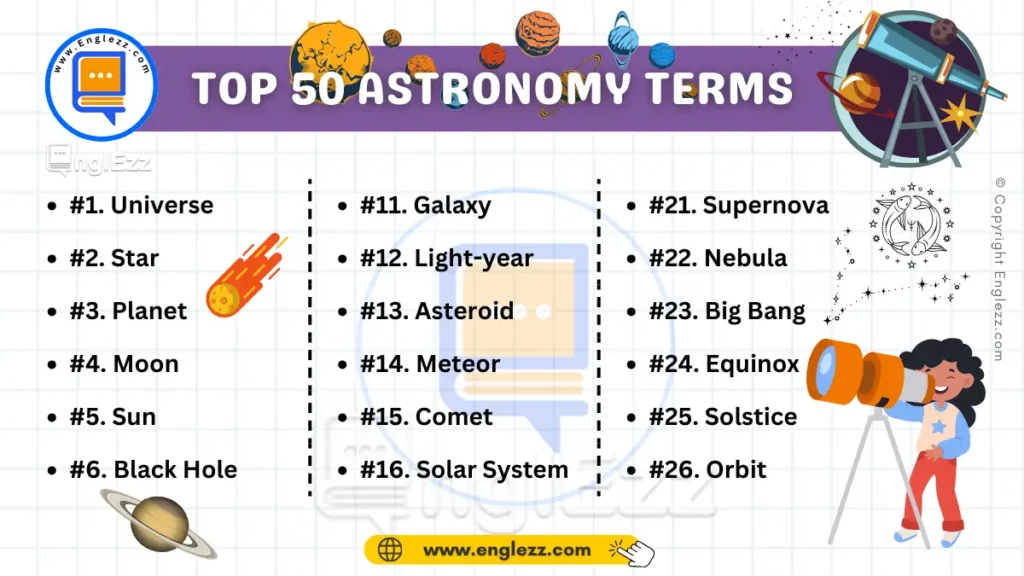The night sky has captivated humanity for millennia, sparking curiosity and wonder. Astronomy, the science of celestial objects and phenomena, provides the framework for understanding the universe beyond our planet. This blog post aims to break down 50 of the most common astronomy English terms, providing clear definitions, phonetic transcriptions, and practical examples.
Whether you’re a stargazer, an aspiring astrophysicist, or just curious about the cosmos, familiarizing yourself with key astronomy terms can greatly enhance your appreciation of the universe.
50 Astronomy English Terms Every Student Must Know
Whether it’s understanding the difference between a star and a planet, or learning what an exoplanet is, you’ll find this guide useful. Dive in and expand your cosmic vocabulary! 🌌
#1. 🌟 Star /stɑːr/
Definition: A massive, luminous sphere of plasma held together by gravity.
Examples:
- The Sun is the closest star to Earth.
- Scientists discovered a new star in a distant galaxy.
#2. 🌑 Planet /ˈplænɪt/
Definition: A celestial body that orbits a star and is massive enough to be rounded by its own gravity.
Examples:
- Earth is the third planet from the Sun.
- Jupiter is the largest planet in our solar system.
#3. 🌠 Meteor /ˈmiːtiər/
Definition: A small body of matter from outer space that enters Earth’s atmosphere, becoming incandescent as a result of friction and appearing as a streak of light.
Examples:
- We saw a meteor streak across the sky last night.
- The annual meteor shower peaks in August.
#4. 🌒 Moon /muːn/
Definition: A natural satellite that orbits a planet.
Examples:
- Earth’s moon affects the tides.
- Jupiter has 79 known moons.
#5. 🌌 Galaxy /ˈɡæləksi/
Definition: A system of millions or billions of stars, along with gas and dust, held together by gravitational attraction.
Examples:
- The Milky Way is our home galaxy.
- Andromeda is the nearest galaxy to the Milky Way.
#6. 🌍 Solar System /ˈsoʊlər ˈsɪstəm/
Definition: The collection of eight planets and their moons in orbit around the Sun, together with smaller bodies like asteroids, meteoroids, and comets.
Examples:
- Our solar system is located in the Milky Way galaxy.
- The solar system formed about 4.6 billion years ago.
#7. ☄️ Comet /ˈkɒmɪt/
Definition: A celestial object consisting of a nucleus of ice and dust. When near the sun, it has a “tail” of gas and dust particles pointing away from the sun.
Examples:
- Halley’s Comet is visible from Earth every 76 years.
- The comet’s tail becomes more prominent as it approaches the Sun.
#8. 🌌 Nebula /ˈnɛbjʊlə/
Definition: A giant cloud of dust and gas in space, some of which are regions where new stars are born.
Examples:
- The Orion Nebula is a birthplace of stars.
- Nebulae are often the remnants of dead stars.
#9. 🌟 Supernova /ˌsuːpərˈnoʊvə/
Definition: A stellar explosion that occurs at the end of a star’s life cycle, resulting in an extremely bright and short-lived burst of radiation.
Examples:
- The Crab Nebula is the remnant of a supernova.
- Supernovae are key to distributing heavy elements in the universe.
#10. 🌍 Exoplanet /ˈɛksoʊˌplænɪt/
Definition: A planet that orbits a star outside our solar system.
Examples:
- Scientists have discovered over 4,000 exoplanets.
- The exoplanet Kepler-452b is considered potentially habitable.
#11. 🌑 Black Hole /blæk hoʊl/
Definition: A region of space having a gravitational field so intense that no matter or radiation can escape.
Examples:
- The supermassive black hole at the center of the Milky Way is called Sagittarius A*.
- Black holes can form from the remnants of massive stars after they collapse.
#12. 🌟 White Dwarf /waɪt dwɔːrf/
Definition: A small, dense star that is the leftover core of a star that has exhausted its nuclear fuel.
Examples:
- Our Sun will eventually become a white dwarf.
- Sirius B is a famous white dwarf star.

#13. 🌌 Quasar /ˈkweɪzɑːr/
Definition: A very energetic and distant active galactic nucleus, powered by a supermassive black hole.
Examples:
- Quasars are among the brightest objects in the universe.
- The light from quasars takes billions of years to reach Earth.
#14. 🌠 Asteroid /ˈæstərɔɪd/
Definition: A small rocky body orbiting the sun, typically found in the asteroid belt between Mars and Jupiter.
Examples:
- An asteroid impact is believed to have caused the extinction of the dinosaurs.
- NASA is monitoring several asteroids that could potentially collide with Earth.
#15. 🌌 Pulsar /ˈpʌlsɑːr/
Definition: A highly magnetized, rotating neutron star that emits beams of electromagnetic radiation.
Examples:
- Pulsars are used by astronomers to study the universe’s structure.
- The first pulsar was discovered in 1967 by Jocelyn Bell Burnell.
#16. 🌟 Red Giant /rɛd ˈdʒaɪənt/
Definition: A luminous giant star in a late phase of stellar evolution when its core hydrogen is depleted.
Examples:
- Our Sun will expand into a red giant in about 5 billion years.
- Betelgeuse is a well-known red giant star.
#17. 🌍 Light-Year /ˈlaɪtˌjɪr/
Definition: A unit of astronomical distance equivalent to the distance that light travels in one year.
Examples:
- The nearest star to Earth is about 4.24 light-years away.
- Astronomers use light-years to measure the vast distances between celestial objects.
#18. 🌌 Event Horizon /ɪˈvɛnt həˈraɪzən/
Definition: The boundary around a black hole beyond which nothing can escape, not even light.
Examples:
- The event horizon is often described as the “point of no return.”
- Anything that crosses the event horizon is forever lost to the black hole.
#19. 🌟 Dark Matter /dɑrk ˈmætər/
Definition: A type of matter that does not emit, absorb, or reflect light, making it invisible, yet its presence is inferred from gravitational effects on visible matter.
Examples:
- Dark matter makes up about 27% of the universe.
- Scientists study galaxy rotations to understand dark matter.
#20. 🌑 Dark Energy /dɑrk ˈɛnərdʒi/
Definition: A mysterious force that is driving the accelerated expansion of the universe.
Examples:
- Dark energy is believed to account for about 68% of the universe.
- The nature of dark energy is one of the biggest questions in cosmology.
#21. 🌍 Big Bang /bɪɡ bæŋ/
Definition: The theory that the universe originated from a very high-density and high-temperature state and expanded.
Examples:
- The Big Bang occurred approximately 13.8 billion years ago.
- Cosmic microwave background radiation is a remnant of the Big Bang.
#22. 🌠 Constellation /ˌkɒnstəˈleɪʃən/
Definition: A group of stars forming a recognizable pattern traditionally named after its apparent form or identified with a mythological figure.
Examples:
- Orion is one of the most recognizable constellations.
- Constellations have been used for navigation for centuries.
#23. 🌌 Cosmos /ˈkɒzmɒs/
Definition: The universe seen as a well-ordered whole.
Examples:
- The study of the cosmos encompasses all aspects of the universe
. 2. Ancient civilizations often pondered the nature of the cosmos.
#24. 🌟 Equinox /ˈikwəˌnɒks/
Definition: The time or date at which the sun crosses the celestial equator, when day and night are of equal length.
Examples:
- The spring equinox marks the beginning of spring.
- The autumnal equinox occurs in September.
#25. 🌍 Solstice /ˈsɒlstɪs/
Definition: Either of the two times in the year when the sun reaches its highest or lowest point in the sky at noon, marked by the longest and shortest days.
Examples:
- The summer solstice is the longest day of the year.
- The winter solstice marks the shortest day and longest night.
#26. 🌑 Orbit /ˈɔːrbɪt/
Definition: The curved path of a celestial object or spacecraft around a star, planet, or moon, especially a periodic elliptical revolution.
Examples:
- The Earth orbits the Sun once every 365 days.
- Satellites are placed in orbit to gather data about our planet.
#27. 🌠 Telescope /ˈtɛlɪˌskoʊp/
Definition: An optical instrument designed to make distant objects appear nearer, containing an arrangement of lenses, or mirrors, or both.
Examples:
- Galileo was the first to use a telescope to observe the stars.
- Modern telescopes can observe objects billions of light-years away.
#28. 🌌 Spectrum /ˈspɛktrəm/
Definition: The band of colors, as seen in a rainbow, produced by separation of the components of light by their different degrees of refraction according to wavelength.
Examples:
- Astronomers study the light spectrum to determine the composition of stars.
- The spectrum of a star can reveal its temperature and chemical makeup.
#29. 🌟 Zenith /ˈzinɪθ/
Definition: The point in the sky or celestial sphere directly above an observer.
Examples:
- The Sun is at its zenith at noon.
- Astronomers measure the zenith distance to determine a star’s position.
#30. 🌍 Aphelion /æˈfiːliən/
Definition: The point in the orbit of a planet, asteroid, or comet at which it is furthest from the sun.
Examples:
- Earth is at aphelion in early July.
- The aphelion of a comet can affect its visibility from Earth.
#31. 🌑 Perihelion /ˌpɛrɪˈhiːliən/
Definition: The point in the orbit of a planet, asteroid, or comet at which it is closest to the sun.
Examples:
- Earth reaches perihelion in early January.
- The speed of a planet increases as it approaches perihelion.
#32. 🌠 Celestial Sphere /səˈlɛstʃəl sfɪr/
Definition: An imaginary sphere of which the observer is the center and on which all celestial objects are considered to lie.
Examples:
- Ancient astronomers used the concept of the celestial sphere to map the stars.
- The celestial sphere is divided into constellations.
#33. 🌌 Eclipse /ɪˈklɪps/
Definition: An event in which the shadow of one celestial body falls on another, particularly involving the Sun or Moon.
Examples:
- A solar eclipse occurs when the Moon passes between the Earth and the Sun.
- The next lunar eclipse will be visible next year.
#34. 🌟 Photon /ˈfoʊtɒn/
Definition: A particle representing a quantum of light or other electromagnetic radiation.
Examples:
- Photons are the fundamental particles of light.
- Solar panels convert photons into electricity.
#35. 🌍 Gravity /ˈɡrævɪti/
Definition: The force that attracts a body toward the center of the earth, or toward any other physical body having mass.
Examples:
- Gravity keeps planets in orbit around the Sun.
- The gravitational pull of the Moon causes ocean tides on Earth.
#36. 🌑 Singularity /ˌsɪŋɡjʊˈlærɪti/
Definition: A point in space where the density of matter and the gravitational field are theoretically infinite, such as at the center of a black hole.
Examples:
- The singularity at the heart of a black hole defies current understanding of physics.
- Some theories suggest the universe began as a singularity.
#37. 🌠 Neutron Star /ˈnjuːtrɒn stɑːr/
Definition: A small, incredibly dense star composed mainly of tightly packed neutrons, usually the result of a supernova explosion.
Examples:
- Neutron stars are among the densest objects in the universe.
- Pulsars are a type of rapidly rotating neutron star.
#38. 🌌 Cosmic Microwave Background /ˈkɒzmɪk ˈmaɪkroʊweɪv ˈbækɡraʊnd/
Definition: The thermal radiation left over from the time of recombination in Big Bang cosmology.
Examples:
- The cosmic microwave background is evidence of the universe’s early state.
- Scientists study the cosmic microwave background to learn about the early universe.
#39. 🌟 Redshift /ˈrɛdˌʃɪft/
Definition: The displacement of spectral lines toward longer wavelengths in radiation from distant galaxies and celestial objects, indicative of their motion away from the observer.
Examples:
- The redshift of galaxies suggests that the universe is expanding.
- Astronomers use redshift to measure the distance to distant objects.
#40. 🌍 Blueshift /ˈbluˌʃɪft/
Definition: The displacement of spectral lines toward shorter wavelengths in radiation from approaching celestial objects.
Examples:
- A star moving toward Earth exhibits a blueshift.
- Blueshift can indicate that an object is moving closer to the observer.
#41. 🌑 Binary Star /ˈbaɪnəri stɑːr/
Definition: A system of two stars that orbit a common center of mass.
Examples:
- Binary star systems are common in the galaxy.
- The motion of binary stars helps astronomers determine stellar masses.
#42. 🌠 Elliptical Galaxy /ɪˈlɪptɪkəl ˈɡæləksi/
Definition: A type of galaxy having an approximately ellipsoidal shape and a smooth, nearly featureless brightness profile.
Examples:
- Elliptical galaxies contain older, low-mass stars.
- M87 is a well-known elliptical galaxy.
#43. 🌌 Spiral Galaxy /ˈspaɪrəl ˈɡæləksi/
Definition: A galaxy characterized by a flat, rotating disk of stars, gas, and dust, with a central bulge and spiral arms.
Examples:
- The Milky Way is a spiral galaxy.
- Spiral galaxies often contain young, hot stars.
#44. 🌟 Lunar Eclipse /ˈluːnər ɪˈklɪps/
Definition: An event where the Earth comes between the Sun and the Moon, and the Earth’s shadow falls on the Moon.
Examples:
- A total lunar eclipse turns the Moon a reddish color, often called a “blood moon.”
- The next lunar eclipse will occur next year.
#45. 🌍 Solar Eclipse /ˈsoʊlər ɪˈklɪps/
Definition: An event where the Moon passes between the Sun and Earth, blocking all or part of the Sun.
Examples:
- A solar eclipse occurs when the Moon completely covers the Sun.
- Solar eclipses can be total, partial, or annular.
#46. 🌑 Aurora /əˈrɔːrə/
Definition: A natural light display in the Earth’s sky, predominantly seen in high-latitude regions around the Arctic and Antarctic.
Examples:
- The aurora borealis, or northern lights, is visible in the polar regions.
- Auroras are caused by the interaction of solar wind with the Earth’s magnetosphere.
#47. 🌠 Magnetosphere /mægˈnɛtəˌsfɪər/
Definition: The region surrounding a planet where its magnetic field is the predominant effective magnetic field.
Examples:
- Earth’s magnetosphere protects us from harmful solar radiation.
- The magnetospheres of other planets, like Jupiter, are much stronger than Earth’s.
#48. 🌌 Space-Time /ˈspeɪsˌtaɪm/
Definition: The four-dimensional continuum in which all objects and events exist, combining the three dimensions of space and one dimension of time.
Examples:
- Einstein’s theory of relativity revolutionized our understanding of space-time.
- The warping of space-time explains the phenomenon of gravity.
#49. 🌟 Exoplanet /ˈɛksoʊˌplænɪt/
Definition: A planet that orbits a star outside our solar system.
Examples:
- Thousands of exoplanets have been discovered in the last few decades.
- Exoplanet Kepler-452b is located in the habitable zone of its star.
#50. 🌍 Astronomy /əˈstrɒnəmi/
Definition: The branch of science that deals with celestial objects, space, and the physical universe as a whole.
Examples:
- Astronomy helps us understand the origins of our universe.
- Modern astronomy relies on powerful telescopes and space missions.
🌌 Table of Astronomy Terms 🌌
| #1. Universe | #11. Galaxy | #21. Supernova |
| #2. Star | #12. Light-year | #22. Nebula |
| #3. Planet | #13. Asteroid | #23. Big Bang |
| #4. Moon | #14. Meteor | #24. Equinox |
| #5. Sun | #15. Comet | #25. Solstice |
| #6. Black Hole | #16. Solar System | #26. Orbit |
| #7. Nebula | #17. Quasar | #27. Telescope |
| #8. Constellation | #18. Pulsar | #28. Spectrum |
| #9. Dark Matter | #19. Dark Energy | #29. Zenith |
| #10. Astrophysics | #20. Event Horizon | #30. Aphelion |
| #31. Perihelion | #41. Binary Star | |
| #32. Celestial Sphere | #42. Elliptical Galaxy | |
| #33. Eclipse | #43. Spiral Galaxy | |
| #34. Photon | #44. Lunar Eclipse | |
| #35. Gravity | #45. Solar Eclipse | |
| #36. Singularity | #46. Aurora | |
| #37. Neutron Star | #47. Magnetosphere | |
| #38. Cosmic Microwave Background | #48. Space-Time | |
| #39. Redshift | #49. Exoplanet | |
| #40. Blueshift | #50. Astronomy |
Conclusion
Understanding astronomy is not just about observing the stars; it’s about comprehending the fundamental concepts that govern the universe. From the basic components like stars and planets to the more complex ideas like black holes and dark matter, each term in this list adds a layer of understanding to the vast, intricate cosmos.
As you explore these 50 terms, remember that each one represents a piece of the cosmic puzzle. Whether you’re a budding astronomer or a curious learner, having a grasp of these concepts can enhance your stargazing experience and broaden your perspective on the universe.
🌠Don’t forget to follow @EnglEzz on social media for more educational content, and use hashtags like #EnglEzz, #vocabulary, and #linguistics to join the conversation!









🌟 Ready to explore the cosmos from the comfort of your screen? ⭐️
🚀Dive into these fascinating astronomy terms and expand your universe of knowledge. For more stellar content, follow and like @EnglEzz on social media!
.
https://www.englezz.com/most-common-astronomy-english-terms/
.
#englezz #vocabulary #linguistics #learnenglish #astronomy #space #stargazing #education #science